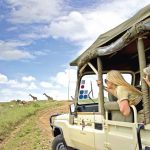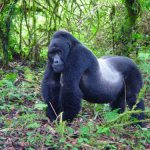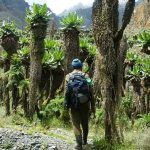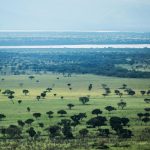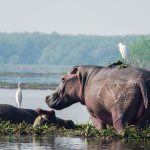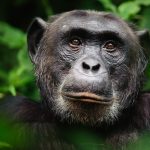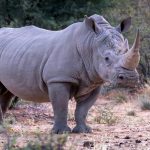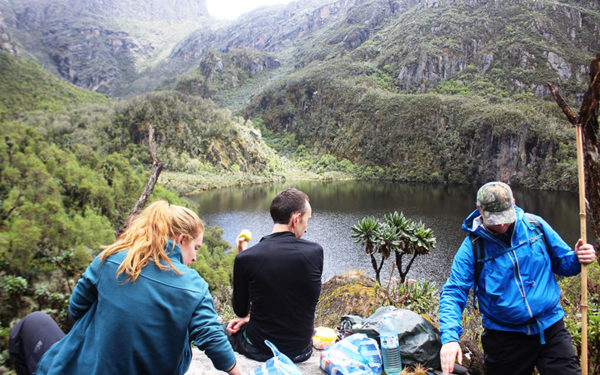
Rwenzori Mountains National Park covers about 100,000 ha in western Uganda and comprises the main part of the Rwenzori mountain chain, which includes Africa’s third highest peak (Mount Margherita: 5,109 m). The region’s glaciers, waterfalls and lakes make it one of Africa’s most beautiful alpine areas. The park has many natural habitats of endangered species and a rich and unusual flora comprising, among other species, the giant heather. First a protected forest in 1941, the 995km Rwenzori mountain National Park was created in 1991 and recognized as a world heritage site in 1994. The Rwenzori is one of the highest mountain range in Africa.
Rwenzori Mountains are the legendary snow-capped mountains of the moon with an elevation of 5,109m.Mt.Stanley is the highest peak and not volcanic.
In 1991 the Rwenzori Mountains were gazetted as a national park hence the name Rwenzori mountains national park. Uganda holds the largest part of the mountain and the other side borded by Congo. The park headquarters are located at the foothills of the mountains. If offers an enjoyable and exciting adventure which must be well planned because it’s very challenging. There six glaciers with permanent covering of snow on the peaks namely Mt.stanley (5,109m),Mt.Speke (4,890m),Mt.Baker (4,843m),Mt.Emin(4,798m),Mt.Gessi(4,715m) and Mt.Luigi di savoia(4,627m).
The luxuriant unique vegetation of Rwenzori boasts of five different vegetation zones including bamboo zone, heather zone and afro alpine, montane forest, grassland and moorland zone. The giant lobelia and groundsels are some of the plants found at the higher altitude. Although known primarily for it’s challenging hiking and climbing possibilities, it supports a diverse range of animals, including 70 mammal amd 177 bird species several of the latter are Albertine Rift Endemics.
The mountain contains a variety of wildlife such as elephant, buffalo and the rare Rwenzori leopard, Rwenzori colobus, Hyrax, Blue monkey and Rwenzori Turaco. It is the only national park in Uganda where the Angola Colobus has been recorded. The localized Angola Colobus can easily be confused with the more wide spread Black- and –white Colobus, and therefore needs to be examined more closely.
The lower slopes of the mountain inhabit some mammals like duikers. Birds species like rwenzori turaco, francolins, olive pigeon, mountain buzzards and white necked raven.
The Rwenzoris offers excellent mountaineering and hiking opportunities which gives one a wonderful and memorable experience. The central circuit which takes 7 days exposes the visitors climbing, unique vegetation and bird experience. It is recommended before climbing, one needs to be in good health condition and physically fit. The rwenzori mountaineering services (RMS) provides all the necessary climbing equipment.
Quick Facts About the Park
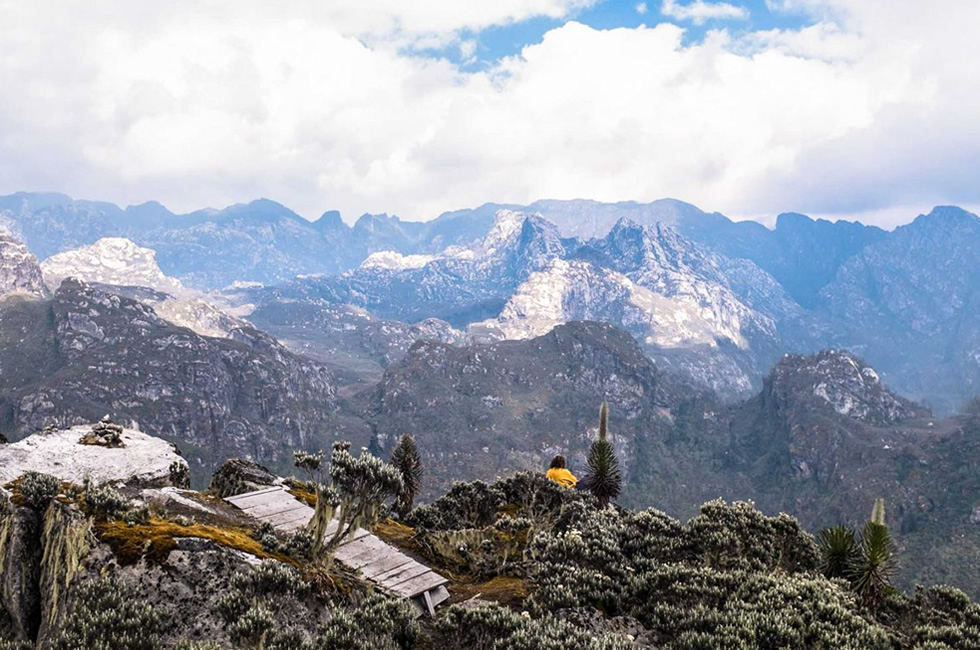
If you are interested in the most experiential hikes, a visit to Mount Rwenzori National Park gets you the best of thrilling hiking experience. This park is situated about 400 kilometers away from Kampala city center, western Uganda and it is bordered by Kabarole, Kasese and Budibugyo district.
This park derived its name from the scenic Rwenzori Mountain ranges which features as the 3rd highest snow peak in Africa and comprises of 6 mountains-Stanley, Emin, Gessi, Savioa, Speke and Baker. It is composed of a rare vegetation zone comprising of the bamboo, moist montane forest, moorland and others. This UNESCO World Heritage Site covers an area of about 1000 square kilometers and boasts of its rare plant species, over 70 mammal species, 217 bird species 19 of which are Albertine rift endemics, waterfalls, the magical Rwenzori mountain ranges among others. A hike to the top of this mountain may last you about 9 or more days to get to the Margherita peak and it is ideal for those who are physically well.
The Rwenzori Mountains, also known as the “Mountains of the Moon,” are a mountain range in eastern Africa located on the border between Uganda and the Democratic Republic of the Congo. Protected by Rwenzori mountains national park, the ranges have the highest peak in Uganda and the third highest on the African continent – Margherita (5,109m). As you plan a trip to the amazing Rwenzori mountains, there is some information you should know and below are some of the facts about the magical features;
Range and Location
The Rwenzori Mountains span an area of about 120 kilometres (75 miles) and are located in the western part of the East African Rift System. They are situated on the border between Uganda (in the south western region) and the Democratic Republic of the Congo (in the northeast part).
Highest Peak
The highest peak in the Rwenzori Mountains is Margherita Peak, which stands at an elevation of 5,109 meters (16,762 feet) above sea level. Margherita Peak is part of Mount Stanley also known as Mount Ngaliema in Congo, one of the major peaks in the range. This peak also stands as the highest summit in Uganda and the third highest on the African continent after Mount Kenya and Kilimanjaro of Tanzania.
Glacial Features
The Rwenzori Mountains are known for their distinctive glacial features, including several glaciers and snowfields. The most prominent glaciers include the Stanley Glacier and the Speke Glacier. However, due to climate change, the glaciers have been receding in recent years.
Biodiversity
The Rwenzori Mountains are recognized as a UNESCO World Heritage Site and are renowned for their exceptional biodiversity. The range is home to a wide variety of plant and animal species, including unique and endemic species. The vegetation zones of the mountains are stratified thus being available at different layers depending on the high you go. At every elevation, a new and unique vegetation zone found as shown below;
- Grassland at 1,000m to 200m
- Montane forests at 2,000m to 2,500m
- Bamboo Zone at 2,500 to 3,000m
- Heather Zone at 3,000m to 4,000m
- Afro-Alpine Zone at 4,000m to the peaks
The Rwenzori Mountains features varying vegetation zones largely determined by altitudes. There are 5 distinct vegetation zones worth exploring on Rwenzori Mountain safaris. They include bamboo zone 2500 to 3500m, Montane 2000-3000m, grassland 1000-2000m, Afro-alpine moorland zone 4000-4500m, heather 3000-4000m. This block mountain also features strikingly beautiful plants at 3000m including the lobelia, giant tree heathers, groundsel and these are unique to the Rwenzori Mountain region.
VEGETATION ZONES- RWENZORI MOUNTAINS
Vegetation zones in the Rwenzori Mountain ranges: The Mountains of the Moon, the Rwenzori Mountains isn’t only most popular for its Margherita peak but also 6 distinct vegetation zones. Straddling in the Western side of Uganda, Mount Rwenzori has a composition of 6 rare vegetation zones 6 mountain ranges including Mount Luigi di Savoia 4627m, Mount Baker 4843m, Mt. Speke 4890m, Mt. Stanley 5109m, Mt. Gessi 4715m & Mt. Emin 4798m.
On a hike to Margherita, trekkers navigate through the 6 distinct vegetation zones. Each altitudinal range features its own vegetation zone;
1800-2500m-Afro Montane Rainforest
From 1800 to 2500m has mainly the Afro-Montane Rainforest. This means, Rwenzori Mountains National Park is one incredible destination offering a unique experience of an Afro montane rainforest experience. At 1800m elevation has significant species of trees such as vernonia adolfi-friderici, symphonia globulifera, yellow wood tree, read stink wood, podocarpus milanjianus. Other species of plants that exist in this area include begonia, balasms, begonia mayari-johannis.
2500-3000m-Bamboo zone
2500-3000m features the typical bamboo zone and this is the gentle slopes of Rwenzori Mountain ranges. This altitudinal range has good soil, favoring growth of bamboo. As you hike upwards, the steep and rocky slopes the bamboo disappears and replaced by tangled undergrowth of an Acanthus-type shrub, mimulopsis ellioti, luxuriant lobelia. Most of these grow mainly around the wet or swampy region. The narrow ridges features the Erica kingaensis, giant heathers, philippia johnstonii.
3000-4000m-Heather zone
The Heather vegetation zone of Rwenzori Mountain range ranges from altitudinal range 3000-4000m. This vegetation zone specifically grows in poor soils such as the ridge tops, boggy and rocky regions. Besides, the thick Sphagnum moss occupies most of the tussocks and the fine lobelia. This region also features plants such as coral pink ground orchid, Disa stairsii, pink flowers,
The drained zone of the Rwenzori Mountains features mixture of woodland with Rapanea rhododendroides dominating. This is a small shrubby kind of tree with rhododendron type of leaves. The Valley area along the Heather zone is also dominated by huge bogs.
4000-4500m, Alpine zone
4000-4500m, Alpine zone is dominated by swampy vegetation including the giant groundsel, thick tangled growth of helichrysum stuhlumani, lobelia, moss, short grass etc. 4300m has only moss, a few tiny plant species, blackish lichens etc. 4500-5000m features only bare rock & glacier. At this elevation range, you will be exploring stunning Margherita Peak on Mount Stanley.
Wildlife in Rwenzori Mountains
The animals in the mountains include;
- Chimpanzees
- Forest elephant
- Hyrax
- Montane squirrel
- Leopard
- Rwenzori duiker
- L’Hoest monkey
- Rwenzori otter
- Rwenzori range frog
- 3 horned chameleon and many others.
Cultural Significance
The Rwenzori Mountains hold cultural and historical significance for the local communities. The Bakonjo and Bamba people, who inhabit the foothills of the range, have a strong cultural connection to the mountains. The mountains are also associated with various folklore and legends.
John Speke’s Exploration
The Rwenzori Mountains gained international attention during the 19th century when the British explorer John Hanning Speke identified them as the fabled “Mountains of the Moon” mentioned by ancient Greek geographer Ptolemy. Speke’s exploration played a crucial role in establishing the source of the Nile River.
National Parks
The Rwenzori Mountains are protected by two national parks. In Uganda, the majority of the range falls within Rwenzori Mountains National Park, which was established in 1991. In the Democratic Republic of the Congo, the mountains are part of Virunga National Park, a UNESCO World Heritage Site.
These are just a few key facts about the Rwenzori Mountains. The range offers a unique and captivating experience for adventurers and nature lovers alike.
Things to see in Mount Rwenzori National Park
Mount Rwenzori National Park is a home to magnificent Rwenzori mountain ranges which comes with waterfalls, blue cirque Lakes, unique vegetation as well as 18 mammal species, 217 avifaunal species, 9 reptiles, elephants, leopards, chimpanzees and many others.
Things to do in Mount Rwenzori National Park
Mountain climbing
Rwenzori Mountain range rewards hikers with the most thrilling adventure and while on a hike, you come across distinct vegetation zones, glaciers and not to forget magical views over its peaks and surrounding areas. Hiking to the peak of this mountain requires some physical wellness in you. This mountain features Mount Stanley, Vittorio Emmanuelle which stands at 4889 meters on Mount Speke, Edward at 4842 meters on Mount Baker.
Trekking
As well, you can also take a 7 day trek around the central tourism circuit and 5 day trek on the Kilembe route to southern parts of the park. The Rwenzori Mountains offer excellent opportunities for mountaineering and trekking enthusiasts. The mountains present a significant challenge due to their steep slopes, dense vegetation, and unpredictable weather. The most popular routes for climbers are; the Rwenzori Central Circuit Trail, which takes around 8-12 days to complete and then the Kilembe route that takes 7 to 10 days to reach the summit.
Rwenzori mountains comprises of several massifs that provide an excellent mountaineering experience and among these include; Mount Stanley or Ngaliema at 5,109m, Mount Speke at 4,890m, Mount Baker at 4,843, Mount Emin at 4,798 m, Mount Gessi at 4,715 m and then Mount Luigi di Savoia at 4,627 m.
Nature walks
If you can’t make it up to the Margherita peak, there is a better option for you to and that is nothing other than nature walks. On nature walk, you have a chance to sight at varied plant species, meet the Bakonzo communities for you to learn more about their cultures and traditions.
Birding
With over 217 bird species that are confined within this park, birders are never left out. Mount Rwenzori National Park boasts of its diverse bird species and while on birding tour, the birds to spot out include barred long tailed cuckoo, long eared owl, Rwenzori Turaco, slender billed starling, Lagden’s bush shrike, blue headed sunbird, barbets, golden winged sunbird, greenbul, handsome francolin, strange weaver, illadopsis, crimson wings, flycatchers, cinnamon chested bee-eaters and many more.
Cultural encounter
A safari to Mount Rwenzori National Park never goes without a visit to nearby local community to experience the African cultures. A cultural tour in this park gets you a chance to learn more about the cultural lifestyles and what they do each day learn more about drumming and unique dances among others. You can also head off to Ruboni village for you to explore more about their lifestyles and other interesting things.
When to visit Mountain Rwenzori National Park
Mount Rwenzori National Park is located along the equator and because of this; most parts are wet compared to other parts in East Africa. The highest rainfall amount is experienced in the eastern slopes and rains kick start from March to May and from September to mid-December. For excellent tour, you can opt to travel to this park from June to September as most parts remain relatively drier. This area experiences temperature range of about 5 to 20 degrees Celsius. Read More
Where to stay in Mount Rwenzori National Park
There are many accommodations for you to spend a night in this park and they include among others-Hotel Margherita which is situated at the base of the mountain just a few kilometers from Kasese town. Amazingly, a side from accommodation, they also offer Rwenzori experience.
The Rwenzori International Hotel-this is located about 3 kilometers off Kasese airstrip just at the base of Rwenzori Mountain range. This provides executive self-contained rooms to single non-self-contained rooms with camping options.
Kitara lodge-this is located about 16 kilometers off Katunguru gate of Queen Elizabeth National Park. This accommodation facility is very keen on environmental conservation and it is built using renewable materials.
The Equator snow lodge-this is also set at the base of the mountain and offers luxury accommodation services. Below it, there is a roaring Mubuku River and its cottages are constructed using the river rocks thus making it a few exceptionally rare facilities for one to spend a night while on safari in this park.
Tropical savanna guesthouse-this is set along the Mbarara-Kasese route within Kasese Town and it is ideal for budget visitors on safari in Mount Rwenzori National Park.
Getting to Mountain Rwenzori National Park
To get to this park, you need about 5 hours or more to drive from Kampala to Kasese. You can take a car rental a 4 wheel drive safari car or a public means although this may not be favorable enough in case you are looking at something comfortable. The popular routes include the Kampala-Fort Portal or Kampala – Mbarara – Queen Elizabeth National Park or alternatively, take a flight from Kajjansi airfield.
What to Pack
What to pack for Rwenzori Mountaineering adventure 2021-2022. There is a long list of things any enthusiastic hiker or climber can carry but a few essentials are a must-have. Hiking or climbing the Rwenzori Mountain ranges/Mountains of the Moon can be challenging and a successful climbing/hiking safari holiday can be achieved when you pack rightly.
What to pack
Hiking boots
When choosing the hiking boots for your Rwenzori Mountain hiking, consider the sturdy boots and they should offer ankle support as you conquer the steep slopes to the Margherita Peak 5109m. The 7-8 days or more trekking through Rwenzori Mountains can be challenging and require you strong boots. The trails like Rwenzori Central Circuit/Kilembe trail, trekkers navigate through the muddy areas, bogs, steep slopes, wooden footpath and the best choice of boots to wear are the lightweight and comfortable.
Sleeping bags
Carry good sleeping bags, warm cloths for your Rwenzori Mountaineering adventure. Preferably, carry waterproof sleeping bags to use for your overnight stay at the huts en-route to Margherita Peak. Warm clothes should also be a must have for cold nights or general weather while on Rwenzori Mountaineering adventure.
Rain jacket/gear/equipment
The weather in the Rwenzori Mountains is entirely unpredictable but with adequate preparation, you certainly have enjoyable climbing/hiking safari experience. Rain jacket or poncho is one of the essentials for your Rwenzori Mountaineering tour. A rain jacket can save you from heavy rains while still trekking along the trails of Rwenzori Mountain ranges.
Daypack
A waterproof daypack is another most valuable item any climber on Rwenzori Mountaineering adventure should have. The daypack is essential for your hiking adventure to have your documents, plus several other valuable items kept safely without getting wet or damaged.
Medical or first aid kit/box
First aid kit or box comes with lots of items to help you in case of emergencies while on Rwenzori Mountaineering. Trekking through Mt. Rwenzori comes with uncertainties and with first aid kit, you can be saved. The kit comes with pack of plasters/bandages, anti sceptic wipes, gloves, sterilizers, ant malaria tabs or anti diarrhoea, liniment.
Hand gloves
Hand/Gardening gloves do play a significant part while you are on Rwenzori Mountaineering. Gloves should be put on to protect your hands not only from cold, keep them warm or have them protected from scratches.
Sunglasses
Find good and strong sunglasses to help protect your eyes from sun rays while climbing Rwenzori Mountains. Besides, you may also have sunscreen on your Rwenzori Mountaineering to protect your skin from sun burn.
Trekking stick/pool
Trekking/climbing pools are essential during your Rwenzori Mountaineering adventure. They are good for providing hikers support when hiking through steep slopes or trails with bogs. Climbing pools can be found at the park briefing area or get one from the safari lodge or hotel.
There are also other equipment you may need to hire on Rwenzori Mountaineering adventure especially if you plan to conquer the Margherita peaks. These include strong climbing shoes, crampon with over 10 teeth to ease your entry to glacier, carabiner in order to rope up on glaciers and rock hiking prior the peak, long rope of over 40m with diameter of about 10mm, figure 8 descender is necessary for abseiling on the rock areas and ice axes per trekker is a must have.
Resources:
- Rwenzori National Park: A Complete guide to Exploring the Rwenzori Mountains National Park
- Rwenzori Info: Official Tourism Information for the Rwenzori Conservation Area
Things to see in Mgahinga National Park

Mgahinga National Park offers refuge to 76 mammal species including the rare mountain gorillas that make up part of 1004 individuals that still thrive on earth today. Besides, there are also elephants, buffaloes, golden monkeys, spotted hyenas, black fronted duikers, giant fronted hogs, bushbuck and not to forget over 115 bird species.
Virunga Volcanoes

It makes up part of the mighty Virunga Conservation Area (VCA) that also comprises of Volcanoes National Park in northwestern Rwanda and the Virunga National Park in eastern DR Congo. Mgahinga Gorilla National Park straddles between elevation 2227 meters and 4127 meters comprising of Virunga Massifs like Gahinga where it derived its name and this straddles at altitude of about 3474 meters, Muhabura at 4127 meters and Sabyinyo volcano at 3645 meters. This park was gazetted in 1991 as a national park mainly to offer refuge to its diverse natural wonders.
Mount Sabyinyo (3669m)

The ‘Old man’s teeth, like an old man, the time has weather-beaten Mt. Sabyinyo’s crown. Seeing the ‘Old man’s teeth on the top of Mt Sabinyo is another superb exploration. This volcano has 3 challenging peaks to climb. Climbing the mountain takes one up an edge along the eastern side of the climb to the peak. If you are to continue, the climb to peak 11 involves walking a ridge with breath-taking drops into the gorges of Rwanda and Uganda, a dual experience you will achieve here and enjoy. And the hike up to peak 111 is steep with several ladders and mush scrambling. Your hands have to get dirty en-route to peak111! But once you reach the top, you will be in Rwanda, the Democratic Republic of Congo, and Uganda, what a triple memorable experience this one is!!! The journey takes about eight hours round trip to cover the 14km stretch.
Mount Gahinga (3474m)
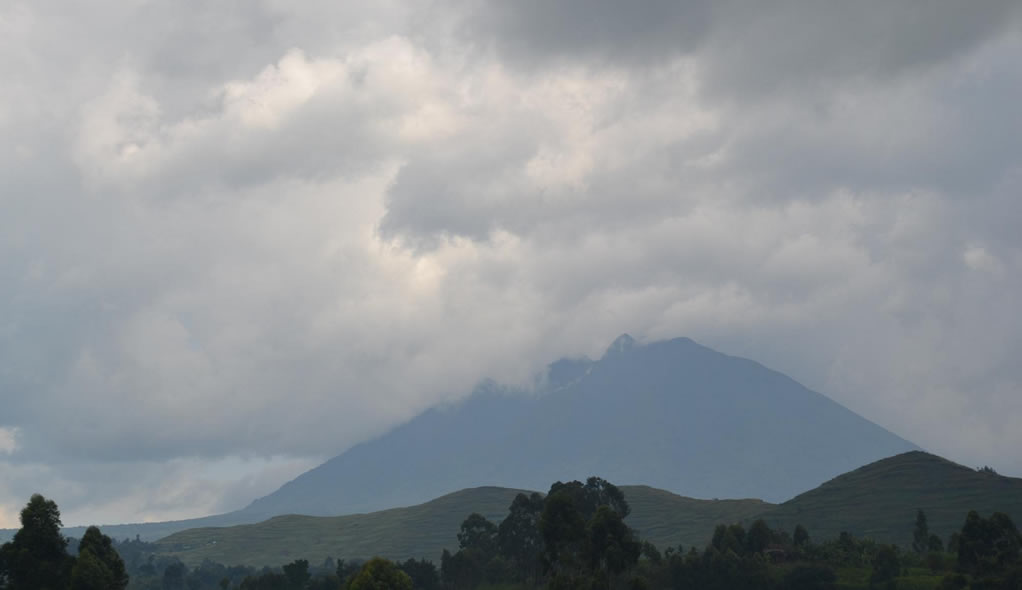
As you are on your way to the park, you will come across small piles of stones in the garden fields locally known as ‘Gahinga’. Mount Gahinga is pretty bigger than the average ‘Gahinga’ but sitting next to Mount Muhavura makes it turn out to be visibly small. Here, a six-hour hike round expedition goes through a good model of a pure Bamboo jungle. Mt. Gahinga at one time had a Crater Lake on its peak but time has altered it into a flourishing swamp which is 8km away.
Mount Muhavura (4127m)

one can well see this volcano from all over Kisoro which acts as a point. The emblematic cone-shaped Mountain provides some of the best views in Uganda. For the most part of the hiking passes a rocky exterior enclosed by grasses and small vegetation. Hikers are presented with the sight of the Virunga volcanoes, Lake Edward in Queen Elizabeth National Park, Bwindi, and the Peak of Rwenzori Mountains once at the top of Muhavura. The trekking exercise takes about 8 hours round trip covering 12km. One is advised to base camp at the Muhavura campsite the night before hiking because the place has no facilities hence you need a tent, water, food, and sleeping stuff amongst others.
Things to do in Mgahinga
Though it is the smallest, it is the most scenic of all of Uganda’s parks. The park sits high in the clouds and it is one of the three Virunga Parks. Popular for gorilla trekking, volcano hiking, and golden monkey tracking, this is the ultimate destination for those looking for an adventurous safari in Uganda.
Gorilla trekking

For those of you who are interested in less crowded gorilla treks, Mgahinga National Park is incredibly the best option. It is Uganda’s second gorilla destination where mountain gorilla tracking is conducted. A gorilla safari in this park begins at Ntebeko with a morning briefing on dos and don’ts to be followed while in the forest searching for a group of mountain gorillas. For visitor experiences, Nyakagezi is the only group that has been habituated and readily set for tourism purposes. Like other destinations, only 8 visitors are allowed to track these creatures in Mgahinga National Park, and permits still cost US$700 per person. Treks to see mountain gorillas in this park may last you about 2 to 6 hours or even more depending on the location of these creatures, the nature of the habitat, and your hiking speed.
Hiking:

Moving from Mgahinga national park trekkers can get higher above to Mt. Sabinyo which 3645metres, Mt Gahinga 3474 meters, and Mt. Muhavura 4127 meters above sea level.
Cave Exploration (The Garama cave)
This is one of the caves were once upon a time the crafty Batwa warriors lived and fought their neighbors, the Bantu. The distance to the cave front entrance from the park headquarters is just 3 km and takes about 4 hours. Your guide will acquaint you with the Batwa history and show you how they lived and fought out of the cave. The cave, 342m in length and 14m deep are at present occupied by bats.
– Viewing platform, is about 800 meters from the Park gate. While on top, you will have a superior visualization of the Park and the neighboring areas. A guide is not considered necessary here and the activity is free of charge. Displaying panels at the hill point will give a quantity of information about what you can see.
– Border trail, is a free 5-hour walk that takes you first in the direction of Sabinyo. The trail goes up to the Sabinyo base for a while through fine montane forest before turning in the direction of the Congo. On your way, you will catch a fine view of Sabinyo’s gorge and peaks. When you go into Congo, you cut backside along the international border and come back to the Park Head offices which is a great segment for bird watching. Also, the two rest huts along the way are excellent places for a break. Observe closely the golden monkeys and elephants as you return. The hiking distance is 10 km.
Mgahinga Bird Watching

Mgahinga Gorilla National Park boasts of about 115 bird species, including a number of species widespread in the East Congo Montane province, and these consist of the Ibis, Whydah, Speckled Mousebirds, and Fire Finch Stonechat, Grey Capped Warbler, Waxbills, and Yellow-Vented Bulbul. For the whole Virunga Conservation Area, over 295 species are prevalent in the Albertine Rift Afromontane region making up 59% of the total of identified common species. Remember to speak to the Park Management for someone to guide you around for good viewing of birds and travel with all your birding equipment like binoculars.
Free Birding

One can enjoy free bird watching on the edges of the park but on request. The guides will take you out from 5-6 pm if you book early by 10 am on the day you want to watch birds. Freely choose your walk direction or simply relax in the camping ground. A gentle walk along the buffalo wall towards the Congo takes you through a wetland area where Ibis, Whydah, Speckled Mousebird, and Fire Finch are found. Stonechat, Grey Capped Warbler, Waxbills, and Yellow-Vented Bulbul are common at the campground. Inquire from the guide about the best spots and take your time and move. Bird Species at Semuliki include the Broad-billed Roller, Green Wood-hoopoe, African Grey Hornbill, African Moustached Warbler, rapacious Red-necked Falcon, Black-winged Red-Bishop, White-winged Widowbird, and Fawn-breasted Waxbill, Double-toothed Barbet, Yellow-throated Leaflove, Green-backed Eremomela, Piapiac, Black-chinned Quail-Finch, Red-shouldered Cuckoo-shrike, and Western Violet-backed Sunbird, the listing is continual. Walk on your own rate as birding needs no rapidity.
Golden monkey tracking
![]()
Mgahinga National Park is remarkable that one place where gold meets silverback. Golden monkey tracking is that one exceptional primate adventure that is offered in this park. Permits for this adventure go at $50 per person and if you wish to take part in golden monkey habituation, you can obtain a permit at $100.
Nature walks

For nature lovers, Mgahinga National Park is perfect while on a nature walk which rewards you with the sights at its lush vegetation, bamboo forest, Rugezi swamp which comes with breathtaking views over the farmlands, Lake Mutanda, and others.
Cultural encounters

Pay a visit to the Batwa community and get the best of Africa’s unique cultures. A visit to this community offers you a chance to interact with the Batwa, explore their incredible cultures and traditions.
Accommodation in Mgahinga National Park

The notable safari lodges for visitor overnight stay while on Uganda safari in Mgahinga National Park include
Clouds Mountain Gorilla Lodge which is situated in the southern sector of Bwindi Impenetrable Forest National Park just along the Nteko ridge;
Nkuringo safari lodge which is situated along the shores of Lake Mutanda just close to Mgahinga National Park;
Mount Gahinga Lodge (Luxury)
Mount Gahinga Lodge lies at the Mgahinga National Park entrance offering an ideal ground for you to track mountain gorillas and golden monkeys and also engage in breathtaking volcano hiking. It features an open fireplace, bar, restaurant, Laundry service, outdoor sitting space for birders and wild plants, solar power, and a sunroom overlooking the volcanoes.
Amajambere Iwacu Community Camp (Budget)
This camp is situated near the Mgahinga National Park entrance and it is about 12 kilometers from Kisoro district and 505 kilometers from Kampala. It offers stunning views of the 8 Virunga Massifs especially the Gahinga, Sabyinyo, and Muhabura. It features five bandas at the camp and two of them are dormitories.
Mucha Hotel Kisoro (Mid range)
This is situated on the banks of River Mucha with amazing views of the banana trees and other flora. It is six kilometers from Kisoro town and has spectacular views of volcanoes and River Mucha. It features 10 en suite bedrooms, with single, double, and twin beds. It has a restaurant, bar, garden area, lounge, and many other facilities.
